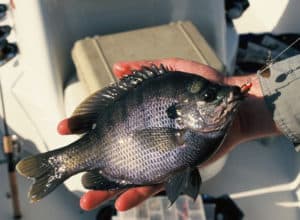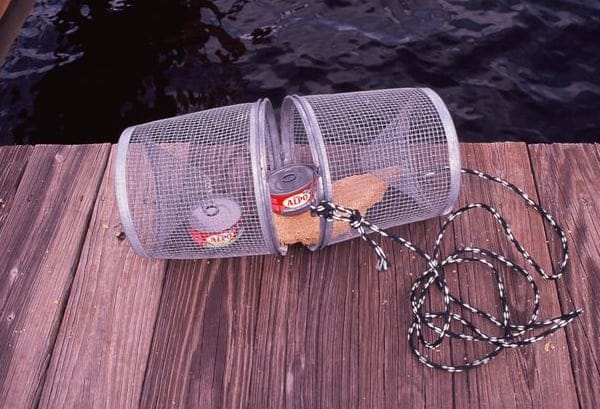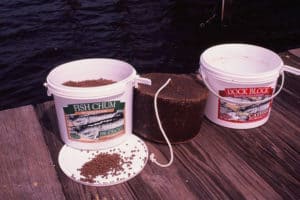By Bob McNally
Some people are blessed with a special flair or inborn ability to locate panfish no matter the time of year, weather or water conditions. But for most anglers, consistently pinpointing concentrations of bluegills and other sunfish is a difficult, hit-or-miss proposition. And you can’t catch panfish unless you know where to find them.

Little fish spell big fun, but even panfish can use a little boost to get them biting at times. That’s where chumming comes into play.
This is precisely the reason some people have learned that the best way to locate panfish is to help panfish find the fishermen. And the easiest way to have panfish seek you is to place bait or “chum” in the water to attract feeding fish.
“Chumming” for panfish is an old country method of fishing that’s been around about as long as fishermen have used cane poles and earth worms. The idea is to put some type of fish food or attractant in the water at a predetermined spot for a few days. Then, after the fish are drawn or attracted into that area, anglers work the place over with lures and baits and catch fish “trained” to feed in a given place.
It’s a simple and remarkably effective system of fishing, that’s particularly effective for panfish. It works for bluegills, shellcrackers, in fact, all of the sunfishes. It’s death on panfish in shallow water, deep water, clear water, murky water, weedy water and rocky water. It works in summer and winter. Moreover, other fish can be ‘chummed’ and caught right along with panfish, including bass, crappie, catfish and a multitude of inshore marine species in brackish water.
One of the original methods of “chumming,” and a technique that still works well today, is to simply stuff a burlap gunny or “croaker” sack with stale bread, rice or corn meal. Next, toss in the sack a brick or rocks for weight, tie it closed, and pitch it into a likely panfish spot. Naturally, a rope should be secured to the sack so it can be retrieved.
The essence or “scent” of bread, rice or corn seeps through the burlap sack and draws feeding minnows, panfish, catfish, and other sportfish from long distances. Fish feed on tiny particles of meal that leeches through the burlap. But they can’t get at huge amounts of food, nor pull the sack away from the precise, designated chumming spot. So they hold in an area feeding for long duration.

Cat food in a wire basket or mess bag and tethered to a dock is a sure-fire bet for plenty of panfish action.
A can of cat food also can be used, and works well from inside a mesh chum bag commonly used in saltwater. The cat food should be only slightly opened, and the weight of the can holds down the bag.
Before actually fishing it’s normally best to “feed” or “chum” a place for several days to draw lots of fish to an area and also “train” them to feeding with abandon. Fish quickly become accustomed to chumming, and once a few fish start flocking to the chummed spot more and more are drawn to it.
By keeping a good supply of chum in a likely panfish location for a day or so, it’s a sure bet a good catch of panfish can be made quickly at the place. Almost any proven panfish bait or lure can work in filling a limit of frenzied panfish following chumming.
Chumming also can be refined to be even more effective than using a croaker sack, brick and bag of rice.
One improvement is simply a convenience in the type bait used as chum. Soybean or cottonseed can be purchased from hardware and feed stores in large 25-pound “cakes.” Such cakes are about two inches thick, two-feet wide and four-feet long; thus they are very convenient to use.
Large blocks of “cake” can be broken into easy-to-handle chunks, and the grain is so tightly compacted and dense that it sinks like a brick. It’s important that chum be heavy, because meal that floats or suspends, drifts away from a specific location. This is a vital key to the success of chumming for panfish. The food must be placed in a small, precise spot, which draws and concentrates fish in a well-defined area – a place where baited hooks or lures can be cast repeatedly to hungry, aggressive panfish that have been “programed” to feed without predator fear.

Cakes of cottonseed make a great panfish chum. These attractants are available at most feed and seed stores.
One tactic that works especially well when using “cake” chum is to bait several panfish spots, each about 200 feet apart, with a single “cake” about the size of a dinner plate. Bait with that size cake for three consecutive days, then on the fourth day, put in a “cake” about 1/4th as large. This draws hungry, aggressive panfish pronto, and they’ll be sure to hit your baited hooks in a hurry because of the reduction in chum used during fishing.
Commercial fish feeders also work well for chumming panfish. Some are special water-resistant models that are excellent for this purpose. The important benefit of such feeders is they have self-timers. Such a feeder need not be maintained consistently by an angler because it holds 50 pounds or more of feed or chum. The feeder can be “programed” to spread special sinking fish food pellets at specified times. Fish soon become accustomed to the “programed” feeding schedule, and when you fish near the feeder you simply adjust it so it doesn’t broadcast feed at a “set” time. Instead, just toss in a small handful of fish food pellets, and begin catching frenzied, hungry panfish drawn to the feeder location.
Economy-minded anglers can use a minnow bucket as a very effective holder of chum for panfish fishing. Merely place commercial fish food or sow or hog pellets inside the bucket, weight it with a brick, and sink it in a chosen panfish fishing spot with a line attached. A five-gallon plastic bucket with a tight-fitting lid (commonly found discarded at construction sites) also can be made into a very effective chum bucket. Simply drill small 1/8-inch diameter holes in the bucket, put weight inside, and fill with commercial fish food or pig pellets. Several such chum buckets sunk on a few choice panfish fishing locations can almost guarantee a fish-filled day on the water.
Don’t think that chumming for panfish only works in small creeks, farm ponds and little lakes. Chumming is fruitful virtually everywhere it’s used, including large open water systems. In fact, on big reservoirs and rivers, the fish populations are large and highly mobile, and that makes for an almost limitless supply of panfish that can be readily attracted to anglers who spend the time and a little effort to chum.
The Union Sportsmen’s Alliance website is designed to provide valuable articles about hunting, fishing and conservation for members of AFL-CIO affiliated labor unions and all sportsmen and sportswomen who appreciate hunting and fishing and want to preserve our outdoor heritage for future generations. If you would like your own story and experience from the outdoors to be considered for our website, please email us at [email protected].







